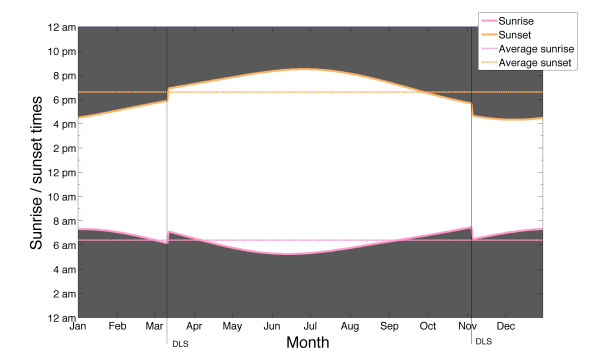Daylight Savings Time Explained
Daylight Savings Time Explained designed by a Visual.ly member under the name Germanium, visually explains the end result of recognizing Daylight Savings Time. DST is used mostly in North America and Europe, while most of the world does not change their clocks.
I tried to come up with the reason for the daylight saving time change by just looking at the data for sunset and sunrise times. The figure represents sunset and sunrise times thought the year. It shows that the daylight saving time change marked by the lines (DLS) is keeping the sunrise time pretty much constant throughout the whole year, while making the sunset time change a lot. The spread of sunrise times as measured by the standard deviation is 42 minutes, which means that the sunrise time changes within that range the whole year, while the standard deviation for the sunset times is 1:30 hours. Whatever the argument for doing this is, it’s pretty clear that reason is to keep the sunrise time constant.
By visualizing the daylight hours, the reader can see the pattern. Both the change in total hours, and the impact of daylight hours on their normal day.
The reasoning for DST is very controversial, but now we can see the impact clearly.









 Randy
Randy

Reader Comments (6)
https://docs.google.com/open?id=0B0v9YWFV5v14MTAxMjM4Y2MtM2Q1Ny00ZjNmLWJlZWEtYWRkZDI3MjdjMTI5
Its not nearly as good looking as Germanium's version - but the core data being conveyed was the bikeshare data; the Sunrise/Sunset piece was not the focus, but was helpful in identifying ridership trends as they related to light/dark conditions.